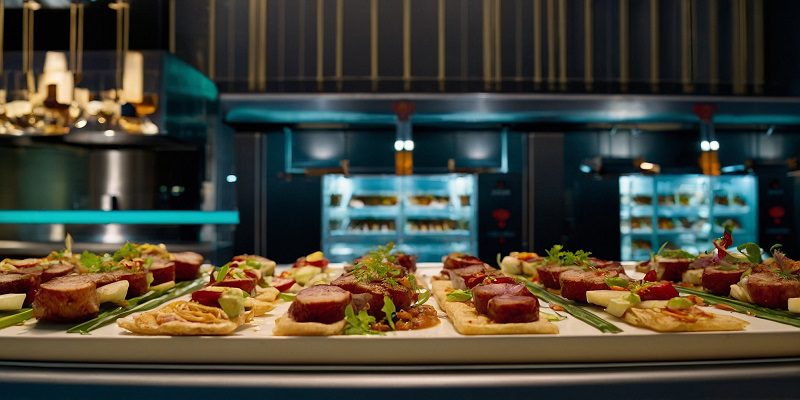Taste of Tomorrow: 10 Ways Technology Transforms Food and Dining

In the ever-evolving landscape of gastronomy, technology plays an increasingly vital role, shaping not only how we produce and consume food but also how we experience dining. From innovative culinary techniques to immersive dining experiences, technology is revolutionizing the way we interact with food at every level. Let’s delve into 10 remarkable ways technology is transforming the taste of tomorrow.
Precision Cooking with Sous Vide Technology
Sous vide technology has emerged as a game-changer in the culinary world, offering precision cooking like never before. By vacuum-sealing ingredients and immersing them in a precisely controlled water bath, chefs can achieve unparalleled consistency and flavor retention. This method allows for the precise cooking of proteins to the perfect doneness, ensuring a tender and succulent outcome every time.
3D Printing:
A New Frontier in Culinary Creativity
The advent of 3D printing has transcended traditional boundaries, extending its reach into the realm of gastronomy. From intricately designed chocolate sculptures to personalized confections, 3D printing allows chefs to unleash their creativity in ways previously unimaginable. This technology opens up a world of possibilities, where edible masterpieces can be crafted with precision and flair.
Farm-to-Table Traceability through Blockchain
Blockchain technology is revolutionizing the way we track and trace the journey of our food from farm to table. By leveraging blockchain’s immutable ledger system, consumers can now access real-time information about the origin, journey, and quality of the products they consume. This transparency not only fosters trust between producers and consumers but also ensures greater accountability throughout the supply chain.
Augmented Reality Menus:
A Feast for the Senses
Augmented reality (AR) menus are transforming the dining experience into a multisensory journey, blending the digital and physical worlds seamlessly. With AR-enabled menus, diners can visualize dishes in stunning detail, explore interactive food pairings, and even embark on virtual culinary adventures. This immersive technology adds a new dimension to dining, engaging all the senses and elevating the overall experience.
Smart Kitchen Appliances for Effortless Cooking
Smart kitchen appliances are redefining convenience in the culinary world, offering intuitive features that streamline the cooking process. From smart ovens that automatically adjust cooking times to intelligent sous vide devices that monitor water temperature remotely, these appliances empower home cooks to create restaurant-quality meals with ease. With built-in connectivity and automation, smart kitchen gadgets are revolutionizing the way we cook and eat at home.
Virtual Reality Dining:
Where Fantasy Meets Flavor
Virtual reality (VR) dining experiences transport diners to fantastical realms where culinary creativity knows no bounds. From dining in space to indulging in a feast fit for royalty, VR dining offers immersive journeys that tantalize the taste buds and ignite the imagination. By combining cutting-edge technology with culinary artistry, these experiences redefine the concept of fine dining, offering a truly unforgettable adventure for the senses.
AI-Powered Food Recommendations for Personalized Dining
Artificial intelligence (AI) is revolutionizing the way we discover and enjoy food, offering personalized recommendations based on individual preferences and dietary requirements. By analyzing vast amounts of data, AI algorithms can suggest dishes, ingredients, and dining experiences tailored to each user’s tastes. Whether it’s finding the perfect restaurant or discovering new flavor combinations, AI-powered food recommendations make dining more enjoyable and fulfilling.
Vertical Farming:
Sustainable Solutions for Urban Agriculture
Vertical farming is reshaping the landscape of agriculture, offering sustainable solutions to the challenges of urban food production. By utilizing vertical space and hydroponic systems, vertical farms can grow fresh produce year-round in urban environments, reducing the need for transportation and minimizing environmental impact. This innovative approach to farming not only ensures access to fresh, nutritious food but also promotes sustainability in food production.
Robotics in the Kitchen:
Efficiency Meets Innovation
Robotics technology is revolutionizing kitchen operations, streamlining processes and enhancing efficiency in food preparation. Additionally, From automated chopping and slicing to robotic chefs capable of creating gourmet meals, these robotic innovations are transforming the culinary landscape. By taking on repetitive tasks and minimizing human error, kitchen robots free up time for chefs to focus on creativity and innovation, ultimately raising the bar for culinary excellence.
Social Dining Platforms:
Connecting Food Enthusiasts Worldwide
Social dining platforms are bringing food enthusiasts together in virtual communities, fostering connections and sharing culinary experiences across the globe. From recipe sharing and cooking challenges to virtual dinner parties and live cooking demonstrations, these platforms create a vibrant ecosystem where food lovers can connect, learn, and inspire one another. Furthermore, By leveraging the power of technology, social dining platforms are uniting people through their shared passion for food, creating a global culinary community unlike any other.
Conclusion
As technology continues to advance at a rapid pace, its impact on the food and dining industry will only continue to grow. Additionally, From precision cooking techniques to immersive dining experiences, technology is reshaping the way we produce, consume, and experience food in profound ways. By embracing innovation and creativity, we can look forward to a future where the taste of tomorrow knows no bounds.





